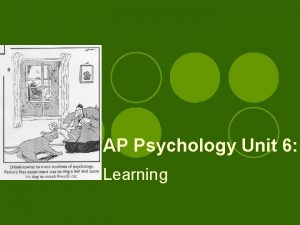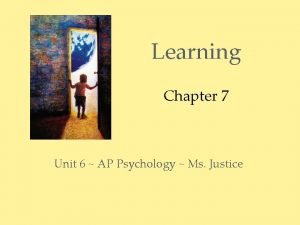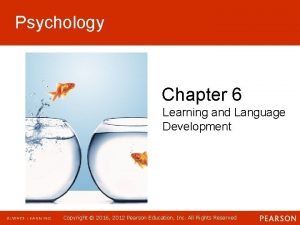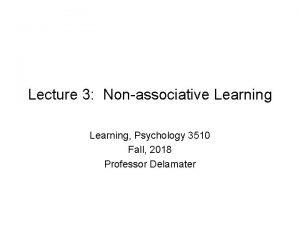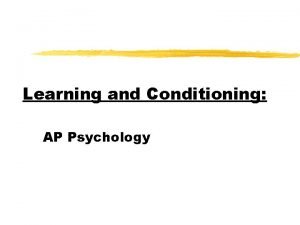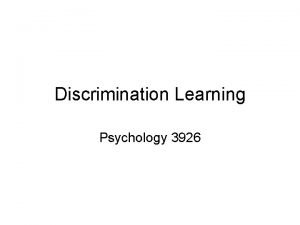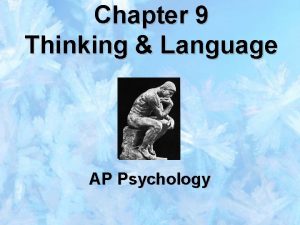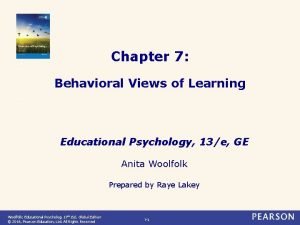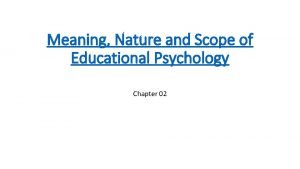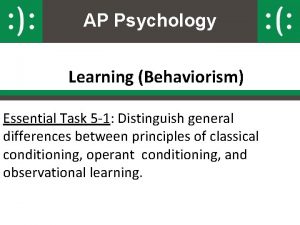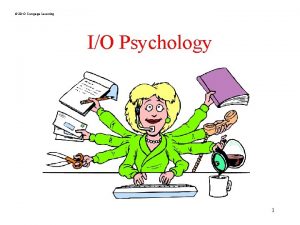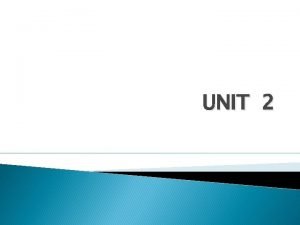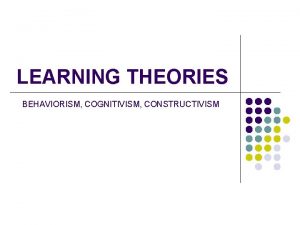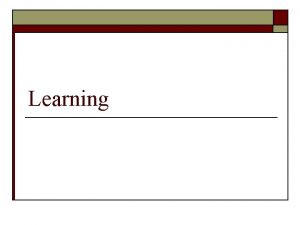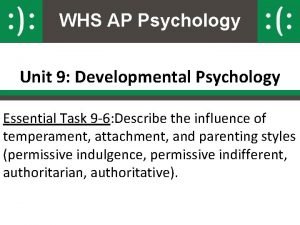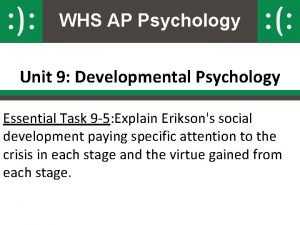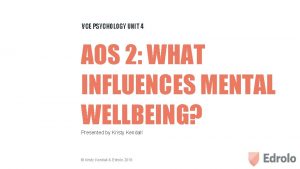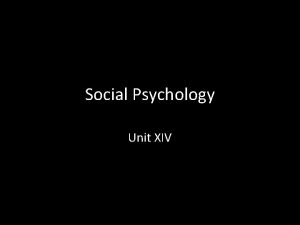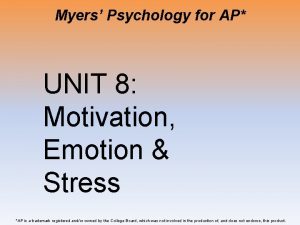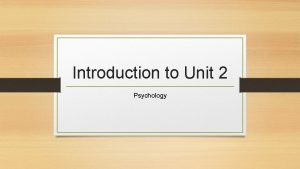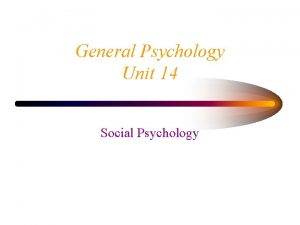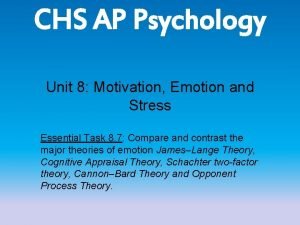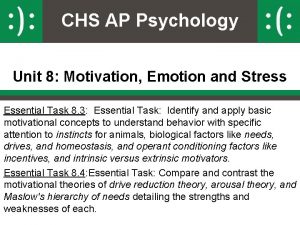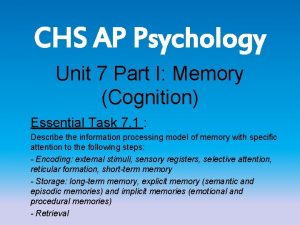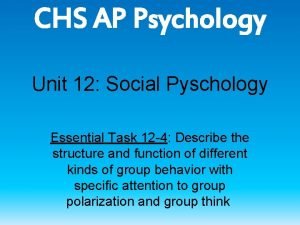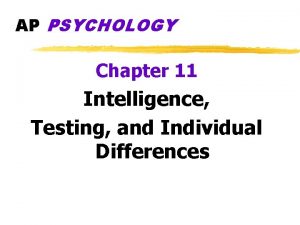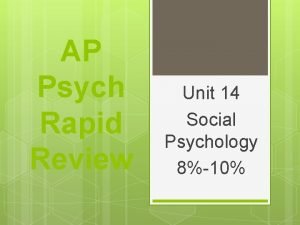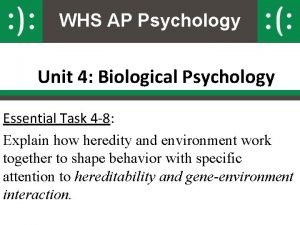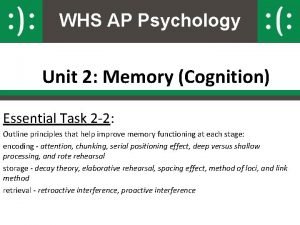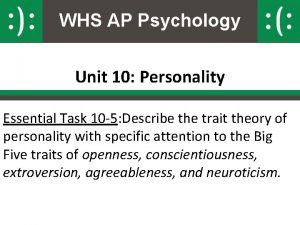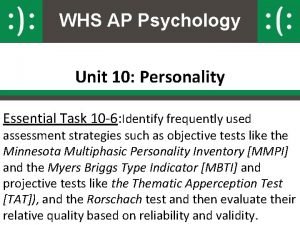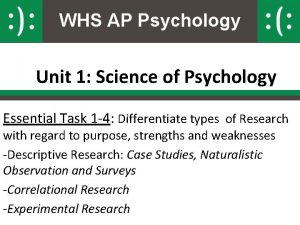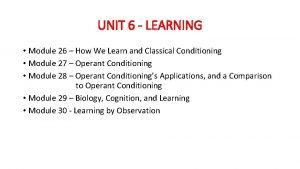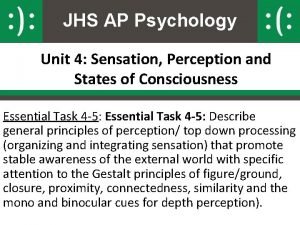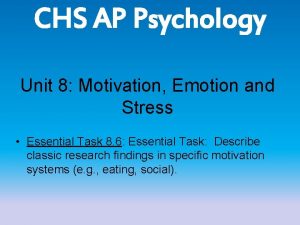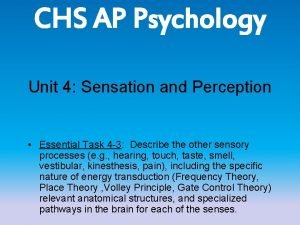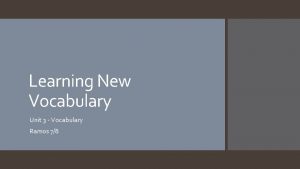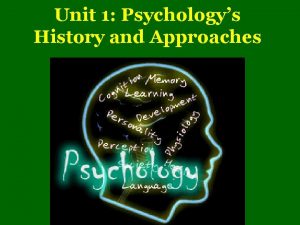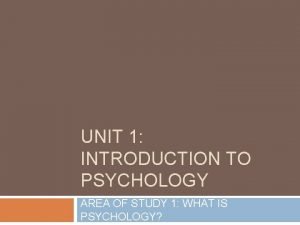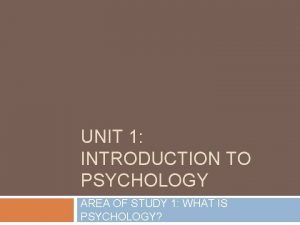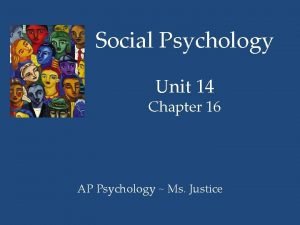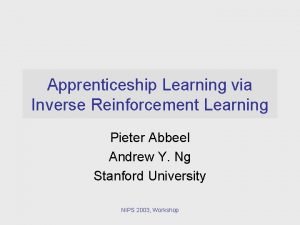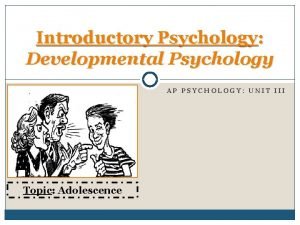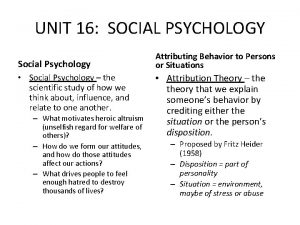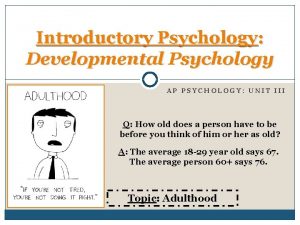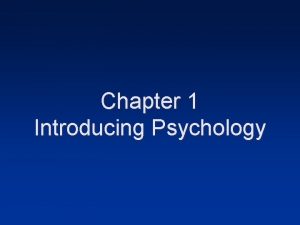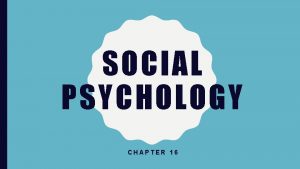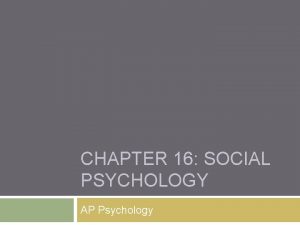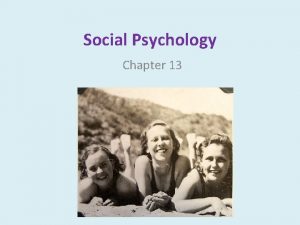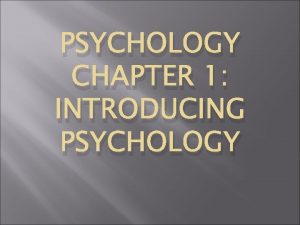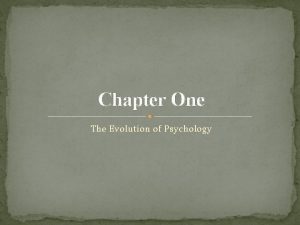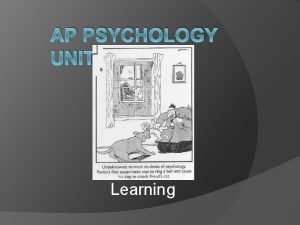Learning Chapter 7 Unit 6 AP Psychology Ms








































































- Slides: 72

Learning Chapter 7 Unit 6 ~ AP Psychology ~ Ms. Justice

BIG IDEAS üHow do we learn? üClassical conditioning § Pavlov’s Experiments § Extending Pavlov’s Understanding § Pavlov’s Legacy üOperant conditioning § § Skinner’s Experiments Extending Skinner’s Understanding Skinner’s Legacy Contrasting Classical & Operant Conditioning üLearning by observation § Bandura’s Experiments § Applications of Observational Learning

1: What are some basic forms of learning?

What is Learning? Learning is a relatively permanent change in an organism’s behavior due to experience. Learning is more flexible in comparison to the genetically-programmed behaviors of Chinook salmon, for example.

How Do We Learn? We learn by association. Our minds naturally connect events that occur in sequence. 2000 years ago, Aristotle suggested this law of association. Then, 200 years ago, Locke and Hume reiterated this law.

Associative Learning to associate one stimulus with another. Toss me a fish!!

Associative Learning to associate one stimulus with another.

Associative Learning to associate a response with a consequence.

2: What is classical conditioning, and how did Pavlov’s work influence behaviorism?

Classical Conditioning Ideas of classical conditioning originate from old philosophical theories. However, it was the Russian physiologist Ivan Pavlov who elucidated classical conditioning. His work provided a basis for later behaviorists like John Watson.

Pavlov’s Experiments

3: How does a neutral stimulus become a conditioned stimulus?

Pavlov’s Experiments Before conditioning: Food produces salivation. However, the tone does not. Food = Unconditioned Stimulus (US) Salivation = Unconditioned Response (UR) Tone = neutral stimulus

Pavlov’s Experiments During conditioning: The neutral stimulus (tone) and the US (food) are paired, resulting in salivation (UR). After conditioning: The neutral stimulus (now Conditioned Stimulus, CS) elicits salivation (now Conditioned Response, CR)

Review! • In Pavlov’s experiment, what is the Ø UR? Ø US? Ø CR? Ø CS? Remember, the UR is unlearned, or unconditionally triggered by the stimulus The CR is learned, or conditioned by the stimulus

Conditioning & the Bike Bell

Conditioning & The Office

4: In classical conditioning, what are the processes of acquisition, extinction, spontaneous recovery, generalization, and discrimination?

Acquisition is the initial learning stage in classical conditioning in which an association between a neutral stimulus and an unconditioned stimulus takes place. 1. In most cases, for conditioning to occur, the neutral stimulus needs to come before the unconditioned stimulus. 2. The time in between the two stimuli should be about half a second.

Acquisition The CS needs to come half a second before the US for acquisition to occur.

Extinction When the US (food) does not follow the CS (tone), CR (salivation) begins to decrease and eventually causes extinction, the diminishing of a conditioned response. Figure 7. 5, p. 297

Spontaneous Recovery After a rest period, an extinguished CR (salivation) spontaneously recovers, but if the CS (tone) persists alone, the CR becomes extinct again.

Stimulus Generalization Tendency to respond to stimuli similar to the CS is called generalization. Pavlov conditioned the dog’s salivation (CR) by using miniature vibrators (CS) on the thigh. When he subsequently stimulated other parts of the dog’s body, salivation dropped.

Stimulus Discrimination is the learned ability to distinguish between a conditioned stimulus and other stimuli that do not signal an unconditioned stimulus.

5: Do cognitive processes and biological constraints affect classical conditioning?

Extending Pavlov’s Understanding Pavlov and Watson considered consciousness unfit for the scientific study of psychology. However, they underestimated the importance of cognitive processes (thoughts, perceptions, and expectations) and biological constraints.

Cognitive Processes Early behaviorists believed that learned behaviors of various animals could be reduced to mindless mechanisms. However, later behaviorists suggested that animals learn the predictability of a stimulus, meaning they learn expectancy or awareness of a stimulus (Rescorla & Wagner, 1972).

Biological Predispositions Pavlov and Watson believed that laws of learning were similar for all animals. Therefore, a pigeon and a person do not differ in their learning. However, behaviorists later suggested that learning is constrained by an animal’s biology.

6: Why is Pavlov’s work important?

Pavlov’s work provided the basis for other experiments that demonstrated: – Classical conditioning is one way that virtually all organisms learn to adapt to their environment – A process such as learning can be studied objectively

7: What have been some applications of classical conditioning?

Applications of Classical Conditioning 1. Former crack cocaine users should avoid cues (people, places) associated with previous drug use. 2. Through classical conditioning, a drug (plus its taste) that affects the immune response may cause the taste of the drug to invoke the immune response. Ader & Cohen, 1985

Applications of Classical Conditioning Brown Brothers John Watson used classical conditioning procedures to test his theory that human emotions and behaviors are merely conditioned responses. He conducted experiments on a 9 month old child named Albert. John B. Watson

“Little Albert” Experiment

8: What is operant conditioning, and how does it differ from classical conditioning?

Operant & Classical Conditioning 1. Classical conditioning forms associations between stimuli (CS and US). Operant conditioning, on the other hand, forms an association between behaviors and the resulting events.

Operant & Classical Conditioning 2. Classical conditioning involves respondent behavior that occurs as an automatic response to a certain stimulus. Operant conditioning involves operant behavior, a behavior that operates on the environment, producing rewarding or punishing stimuli. – Actions followed by reinforcers increase; those followed by punishers decrease.

Skinner’s Experiments B. F. Skinner’s experiments extend psychologist Edward Thorndike’s thinking, especially his law of effect. This law states that rewarded behavior is likely to occur again. Yale University Library Fish was the reward used to entice cats to find their way out of Thorndike’s puzzle box in 1898.

Operant Chamber Skinner developed the operant chamber, or Skinner box, which contains a bar or key that an animal manipulates to obtain food or water. The food or water is a reinforcer, an event that strengthens the behavior it follows. The bar or key is connected to devices that record the animal’s response.

Shaping is the operant conditioning procedure in which reinforcers guide behavior towards the desired target behavior through successive approximations. Fred Bavendam/ Peter Arnold, Inc. Khamis Ramadhan/ Panapress/ Getty Images A rat shaped to sniff mines. A manatee shaped to discriminate objects of different shapes, colors and sizes.

9: What are the basic types of reinforcers?

Types of Reinforcers A heat lamp positively reinforces a meerkat’s behavior in the cold. Table 7. 1, p. 307

Primary & Conditioned Reinforcers 1. Primary Reinforcer: An innately reinforcing stimulus like food (when hungry) or drink (when thirsty). 2. Conditioned Reinforcer: A learned reinforcer that gets its reinforcing power through association with the primary reinforcer. Money is a conditioned reinforcer (desire for money is derived from the desire for food and other necessities).

Immediate & Delayed Reinforcers 1. Immediate Reinforcer: A reinforcer that occurs instantly after a behavior. A rat gets a food pellet for a bar press. 2. Delayed Reinforcer: A reinforcer that is delayed in time for a certain behavior. A paycheck that comes at the end of a week. We may be inclined to engage in small immediate reinforcers (watching TV) rather than large delayed reinforcers (getting an A in a course) which require consistent study.

10: How do different reinforcement schedules affect behavior?

Reinforcement Schedules 1. Continuous Reinforcement: Reinforces the desired response each time it occurs (rarely occurs in real life). 2. Partial Reinforcement: Reinforces a response only part of the time. Though this results in slower acquisition in the beginning, it shows greater resistance to extinction later on.

Ratio Schedules 1. Fixed-ratio schedule: Reinforces a response only after a specified number of responses. e. g. , a free drink after every 5 purchased at the local coffee shop. 2. Variable-ratio schedule: Reinforces a response after an unpredictable number of responses. This is hard to extinguish because of the unpredictability. (e. g. , behaviors like gambling, fishing. )

Interval Schedules 1. Fixed-interval schedule: Reinforces a response only after a specified time interval has elapsed. (e. g. , preparing for an exam only when the exam draws close. ) 2. Variable-interval schedule: Reinforces a response at unpredictable time intervals, which produces slow, steady responses. (e. g. , pop quiz. )

Schedules of Reinforcement Figure 7. 13, page 309

11: How does punishment affect behavior?

Punishment is an event that decreases the behavior it follows.

Punishment Although there may be some justification for occasional punishment (Larzelaere & Baumrind, 2002), it usually leads to negative effects: 1. 2. 3. 4. Results in unwanted fears. Conveys no information to the organism. Justifies pain to others. Causes unwanted behaviors to reappear in its absence. 5. Causes aggression towards the agent. 6. Causes one unwanted behavior to appear in place of another.

12: Do cognitive processes and biological constraints affect operant conditioning?

Cognition & Operant Conditioning Evidence of cognitive processes during operant learning comes from rats during a maze exploration in which they navigate the maze without an obvious reward. Rats seem to develop cognitive maps, or mental representations, of the layout of the maze (environment).

Latent Learning Such cognitive maps are based on latent learning, which becomes apparent only when there is an incentive to demonstrate it.

Intrinsic Motivation: The desire to perform a behavior for its own sake. Extrinsic Motivation: The desire to perform a behavior due to promised rewards or threats of punishments.

Skinner’s Legacy Falk/ Photo Researchers, Inc . Skinner argued that behaviors were shaped by external influences instead of inner thoughts and feelings. Critics argued that Skinner dehumanized people by neglecting their free will. Skinner’s reply to his critics: External consequences already haphazardly control people’s behavior. Why not administer those consequences toward human betterment?

13: How might operant conditioning principles be applied at school, at work, and at home?

Applications of Operant Conditioning Skinner introduced the concept of teaching machines that shape learning in small steps and provide reinforcements for correct rewards. LWA-JDL/ Corbis Skinner would likely approve of today’s interactive student software, web-based learning, and online testing. In School

Applications of Operant Conditioning Reinforcers affect productivity. Many companies now allow employees to share profits and participate in company ownership. Rewards are most likely to increase productivity if the desired performance has been well-defined and is achievable. At work

Applications of Operant Conditioning In children, reinforcing good behavior increases the occurrence of these behaviors. Ignoring unwanted behavior decreases their occurrence. At Home

Operant vs. Classical Conditioning Table 7. 4, page 316

14: What is observational learning, and how is it enabled by mirror neurons?

Learning by Observation ©Herb Terrace The monkey on the right imitates the monkey on the left in touching the pictures in a certain order to obtain a reward. © Herb Terrace Higher animals, especially humans, learn through observing and imitating others.

Reprinted with permission from the American Association for the Advancement of Science, Subiaul et al. , Science 305: 407 -410 (2004) © 2004 AAAS. Mirror Neurons Neuroscientists discovered mirror neurons in the brains of animals and humans that are active during observational learning.

Learning by observation begins early in life. This 14 -month-old child imitates the adult on TV in pulling a toy apart. Meltzoff, A. N. (1998). Imitation of televised models by infants. Child Development, 59 1221 -1229. Photos Courtesy of A. N. Meltzoff and M. Hanuk. Imitation Onset

Bandura's Bobo doll study (1961) indicated that individuals (children) learn through imitating others who receive rewards and punishments. Courtesy of Albert Bandura, Stanford University Bandura's Experiments

Applications of Observational Learning Unfortunately, Bandura’s studies show that antisocial models (family, neighborhood or TV) may have antisocial effects.

15: What is the impact of prosocial modeling and of antisocial modeling?

Positive Observational Learning Bob Daemmrich/ The Image Works Fortunately, prosocial (positive, helpful) models may have prosocial effects.

Gentile et al. , (2004) shows that children in elementary school who are exposed to violent television, videos, and video games express increased aggression. Ron Chapple/ Taxi/ Getty Images Television and Observational Learning

Modeling Violence Children modeling after pro wrestlers Glassman/ The Image Works Bob Daemmrich/ The Image Works Research shows that viewing media violence leads to an increased expression of aggression.
 Tolman ap psychology
Tolman ap psychology Basic forms of learning
Basic forms of learning Two factor theory psychology
Two factor theory psychology Cuadro comparativo e-learning m-learning b-learning
Cuadro comparativo e-learning m-learning b-learning Chapter 6 learning and language development
Chapter 6 learning and language development Unit 10, unit 10 review tests, unit 10 general test
Unit 10, unit 10 review tests, unit 10 general test Positive psychology ap psychology definition
Positive psychology ap psychology definition Social psychology ap psychology
Social psychology ap psychology Nature and scope of psychology
Nature and scope of psychology Social psychology is the scientific study of:
Social psychology is the scientific study of: Health psychology definition ap psychology
Health psychology definition ap psychology Ib psychology learning outcomes
Ib psychology learning outcomes Cognitive insight learning
Cognitive insight learning Factors affecting learning in psychology
Factors affecting learning in psychology Latent learning
Latent learning Habituation psychology
Habituation psychology Differentiated learning theories
Differentiated learning theories Insight learning ap psychology
Insight learning ap psychology Peak shift psychology
Peak shift psychology Belief perseverance ap psychology example
Belief perseverance ap psychology example Behavioral views of learning
Behavioral views of learning What is nature of
What is nature of Non-associative learning definition
Non-associative learning definition Social learning theory ap psychology
Social learning theory ap psychology Portage learning abnormal psychology
Portage learning abnormal psychology Cengage learning psychology
Cengage learning psychology Learning definition psychology
Learning definition psychology Behaviorism vs constructivism vs cognitivism
Behaviorism vs constructivism vs cognitivism Positive constructive helpful behavior
Positive constructive helpful behavior Secure vs insecure attachment ap psychology
Secure vs insecure attachment ap psychology Unit 9 developmental psychology
Unit 9 developmental psychology Unit 4 aos 2 psychology
Unit 4 aos 2 psychology Unit xiv social psychology
Unit xiv social psychology Bulimia nervosa ap psychology definition
Bulimia nervosa ap psychology definition Repeated measures design psychology
Repeated measures design psychology Unit 14 reading guide social psychology
Unit 14 reading guide social psychology Ap psychology unit 8 test
Ap psychology unit 8 test Homeostasis ap psychology
Homeostasis ap psychology Ap psychology unit 7
Ap psychology unit 7 Deindividuation ap psychology
Deindividuation ap psychology Ap psychology chapter 11
Ap psychology chapter 11 Ap psych social psychology
Ap psych social psychology Ap psychology unit 7 cognition
Ap psychology unit 7 cognition Ap psychology unit 4
Ap psychology unit 4 Wagner preference inventory
Wagner preference inventory Decay theory example
Decay theory example Ap psychology unit 10
Ap psychology unit 10 Unit 10 personality ap psychology test
Unit 10 personality ap psychology test Correlational research psychology
Correlational research psychology Module 26 ap psychology
Module 26 ap psychology Types of perception
Types of perception Unit 8 motivation and emotion
Unit 8 motivation and emotion Ap psychology unit 4
Ap psychology unit 4 Ap psychology unit 8 test
Ap psychology unit 8 test Authoritariam
Authoritariam Group polarization
Group polarization Unit 3 vocabulary in context
Unit 3 vocabulary in context Ap psychology unit 3
Ap psychology unit 3 Which drug dampens responsiveness to irrelevant stimuli
Which drug dampens responsiveness to irrelevant stimuli The 7 approaches to psychology
The 7 approaches to psychology Unit 1 introduction to psychology
Unit 1 introduction to psychology Unit 1 introduction to psychology
Unit 1 introduction to psychology Chapter 16 social psychology
Chapter 16 social psychology Yerkes dodson law ap psychology example
Yerkes dodson law ap psychology example Ap psychology behaviorism
Ap psychology behaviorism Ap psychology unit 14
Ap psychology unit 14 Lda supervised or unsupervised
Lda supervised or unsupervised Concept learning task in machine learning
Concept learning task in machine learning Analytical learning in machine learning
Analytical learning in machine learning Eager learning
Eager learning Conceptual learning definition
Conceptual learning definition Deductive learning vs inductive learning
Deductive learning vs inductive learning Apprenticeship learning via inverse reinforcement learning
Apprenticeship learning via inverse reinforcement learning
